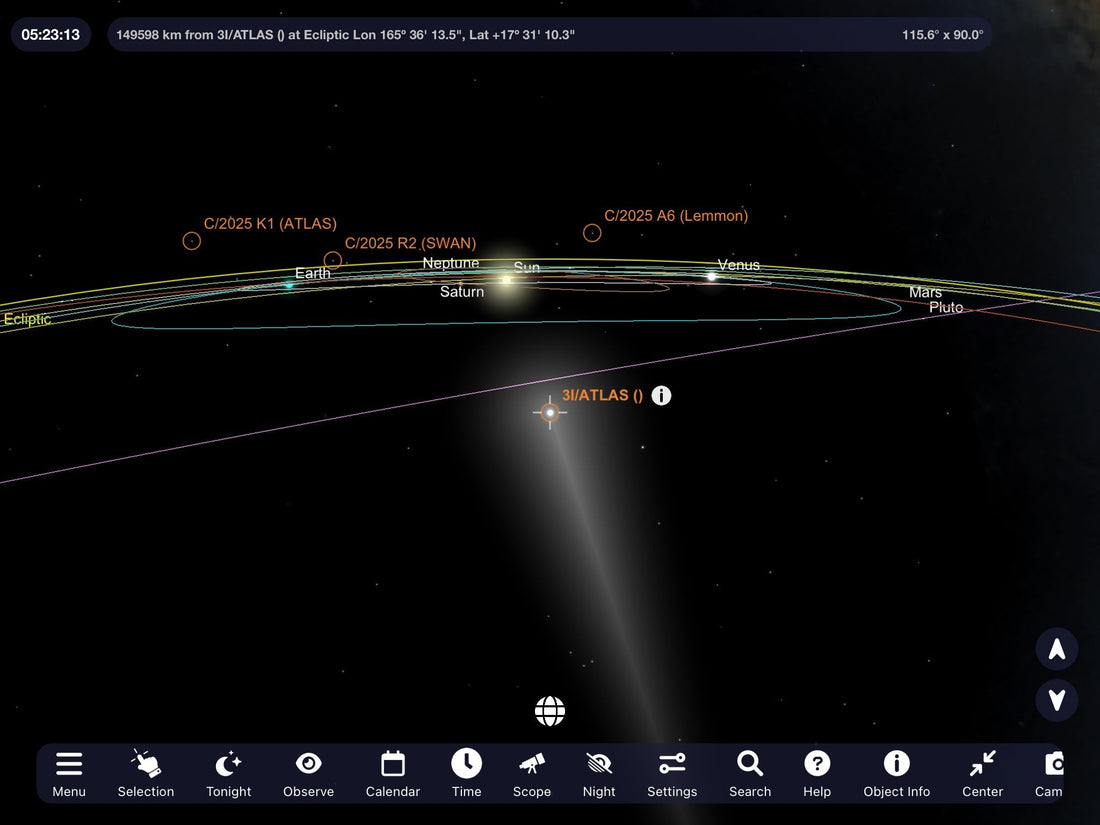
Comet Chaos: A SkySafari Spectacle
Share
October 2025 brings Comet Chaos, a cosmic carnival of three dazzling wanderers streaking through the heavens. There’s R2 (SWAN), the Sun-skimming surprise now strutting past the Eagle and Omega Nebulae; A6 (Lemmon), the late-blooming luminary glowing brighter by the night; and 3I/ATLAS, the galactic guest from beyond the stars, whispering secrets of other worlds. Fire up SkySafari to follow their trails, chart their dance, and join the celestial circus because the universe, it seems, is in the mood for a little drama this October.

Comet C/2025 R2 (SWAN): The Sun-Skirting Surprise
In mid September a Comet that had avoided detection made its closest pass to the Sun and had an outburst that dramatically increased its brightness. Comet C/2025 R2 (SWAN) will be visible from both the Northern and Southern hemispheres this October. Even though it is not predicted to be a naked eye target, it should show up nicely in a pair of binoculars or a telescope.
Download SkySafari 7 Pro 60% OFF
🌟 Comet C/2025 A6 (Lemmon): The Late-Blooming Luminary
Comet Lemmon began 2025 as a dim afterthought but has blossomed into the belle of the October skies. By month’s end it could glow around magnitude 4, right at the threshold of naked-eye brilliance, as it drifts from Canes Venatici toward Boötes and above bright Arcturus. SkySafari makes comet chasing easy: tap, zoom, and follow Lemmon’s nightly climb into the northwest. Proof that even the quietest comets can rise to cosmic celebrity status with the right spotlight.
Download SkySafari 7 Pro 60% OFF
🌌 Comet 3I/ATLAS: The Galactic Guest
Every so often, our Solar System receives a guest from the stars. In 2017 it was the mysterious 1I/‘Oumuamua, and in 2019, comet 2I/Borisov. Now, astronomers have discovered a third such traveler: 3I/ATLAS, a comet that formed around another star and is now paying us a brief visit before disappearing forever into the depths of interstellar space.

3I/ATLAS was first spotted on 1 July 2025 by the ATLAS survey telescope in Chile, when it was nearly as far from the Sun as Jupiter. Astronomers quickly realized its orbit wasn’t bound to our star. Instead, it follows a hyperbolic path, the unmistakable signature of an interstellar object.
Though faint, its chemistry rich in carbon dioxide makes it a scientific gem, offering a rare glimpse into alien planetary ingredients. With SkySafari, you can trace its hyperbolic escape path before it slips forever into the dark. It’s a faint traveler with a vast tale, a whisper from the wider galaxy reminding us how wonderfully far the night can reach.
Keep tabs on all the universe has to offer in SkySafari. 60% OFF thru 10/21/25




7 comments
I’m excited
The Haley comete from Puerto Rico in the 80’s I was 11 years old
Hasan, go out on a moonless night and find the dimmest star you can see. Then look for that star in Sky Safari and get its apparent magnitude. THAT is your sky’s limiting magnitude where you are, so anything brighter than that you know will be visible where you are (without the moon).
The first comet I ever saw was Haley’s Comet in March 1986. I was 18yrs old. It is what put the bug in my soul for space and everything in it
Ok